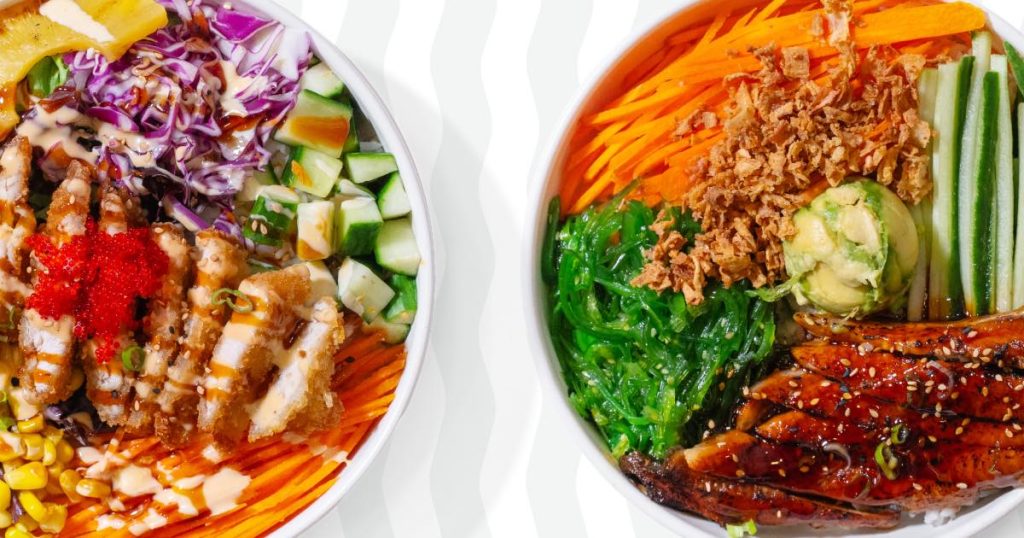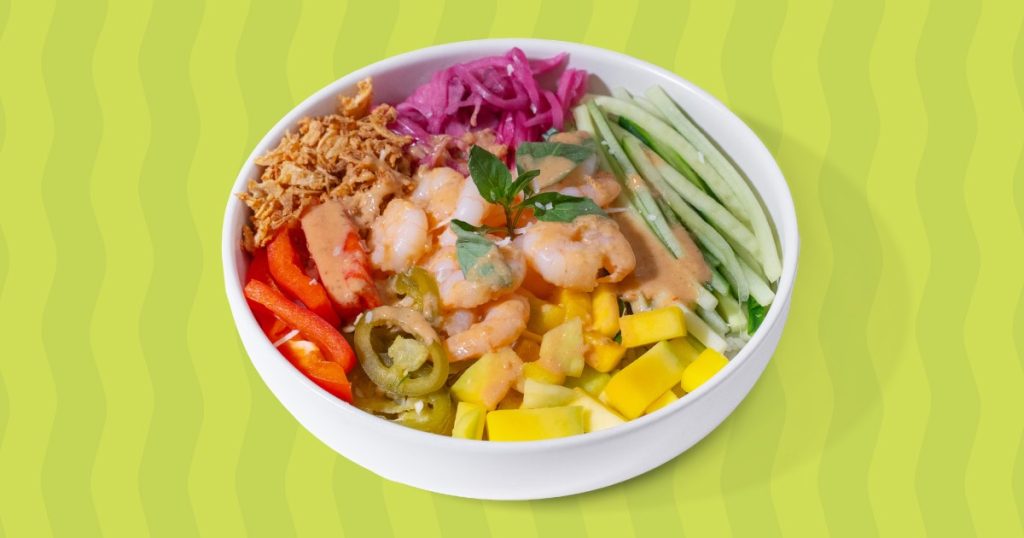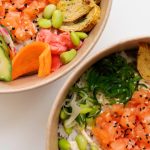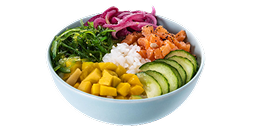We know the feeling. You see those vibrant, perfectly assembled poké bowls all over social media and in every fast-casual line-up. You love the idea: the convenience, the fresh vegetables, the delicious sauces, but there’s one major problem: raw fish.
Maybe you can’t get past the texture, the sliminess, or the sheer idea of uncooked protein. Perhaps you’re highly sensitive to food safety concerns or worried about mercury levels. Whatever the reason, if poké bowls were strictly limited to raw tuna and salmon, a massive number of people would be permanently excluded from this popular, healthy trend.
The good news? You don’t have to miss out. The explosion in the poké market proves that the dish’s true genius lies not in its traditional raw foundation, but in its ability to adapt. The expansion has been fueled entirely by a brilliant solution: embracing a diverse spectrum of cooked and plant-based alternatives. This move transformed the poké concept from a niche item into a truly universal, customizable, and accessible meal format for absolutely everyone.
Why Consumers Say “No” to Raw Fish

The choice to skip raw protein isn’t about being picky; it’s rooted in legitimate concerns over safety, long-term health, and simply enjoying the eating experience.
Perceived Risk & Health Consciousness
When you look at a beautiful bowl of raw, marinated fish, you are putting an enormous amount of trust in the supply chain. For many consumers, that risk factor is simply too high.
The primary hesitation stems from the fear of foodborne illness or parasites. While professional poké restaurants adhere to strict “sushi-grade” sourcing and freezing protocols, the anxiety remains real. Cooked proteins offer an immediate, zero-risk solution, providing total certainty and predictability every time. On the health front, there’s also growing consumer awareness about mercury levels. Larger, raw fish like certain tuna varieties can contain higher mercury concentrations. This steers many health-conscious consumers, especially those eating poké frequently, toward lower-mercury choices, often found in cooked seafood or plant-based proteins.
The Texture Aversion Factor
Beyond the worry, sometimes it just comes down to the way it feels. For the massive population that doesn’t regularly eat sushi, the soft, marinated texture of raw fish can be an immediate turn-off.
The texture aversion is significant: some people simply don’t enjoy the soft, slightly gelatinous mouthfeel of uncooked protein. This is where the alternatives shine. Cooked proteins offer reliable, familiar textures that are comforting and satisfying. Whether it’s the firm, springy chew of cooked shrimp or the appealing crispiness and substantial bite of fried alternatives like Katsu, these options contrast beautifully with the cool, fluffy rice and soft toppings, offering an irresistible sensory experience.
Alternatives to Raw Fish in Poké Bowls
The success of the modern poké bowl rests on the principle that the bowl is a format, not a fixed recipe. If you don’t like raw fish, you simply swap the protein without sacrificing the flavor, texture, or nutrition of the overall meal. These strategic alternatives are the driving forces of market growth, satisfying nearly every palate:
Cooked Seafood
These options offer the rich flavor and high protein of ocean ingredients without any of the risks or texture issues associated with being raw:
- Shrimp: A universal favorite, cooked shrimp provides a reliable, springy chew and a familiar flavor. It’s low-risk and pairs perfectly with all major poké sauces.
- Crab Sticks (Imitation Crab): A highly recognizable and pre-cooked choice. This option is low-risk, affordable, and offers a soft, flaky texture that satisfies the desire for a familiar seafood base.
- Unagi (Eel): Always served fully pre-cooked, often grilled and glazed with a sweet, savory sauce. It delivers a rich, savory profile that adds depth and comfort to the bowl, entirely bypassing the raw debate.
Cooked Poultry
Introducing non-seafood proteins was the critical move that took poké bowls from the sushi niche to the fast-casual mainstream.
- Chicken Katsu: This is the champion of textural contrast. The fried, panko-breaded chicken provides a satisfyingly crispy crunch that works beautifully with cool rice and creamy sauces, transforming the bowl into a comfort meal.
- General Tso Chicken: By including a widely recognized Asian comfort food, restaurants instantly welcome an audience who loves familiar, tangy flavors, making the poké format instantly accessible.
Plant-Based & Vegan
For consumers seeking healthier, sustainable, or purely non-animal options, plant-based proteins are essential.
- Tofu (Marinated & Fried): Tofu is the ideal champion of the vegan poké bowl. Because its flavor is neutral and its structure is porous, it becomes the perfect vehicle for intense flavor absorption. When marinated and often lightly fried, it absorbs the defining “poké” flavor better than almost any other protein.
How to Find These Alternatives at Olu Olu Poké

If you’ve realized that the genius of the poké bowl is in its flexibility, you need a location that executes these alternatives perfectly. That’s where places like Olu Olu Poké shine. We don’t just offer these proteins as a minor option; we build entire signature menu items around them, ensuring that the sauces, rice, and toppings are optimized for the cooked or plant-based protein you choose.
Cooked Seafood Selections
For the consumer who wants the taste of the ocean but not raw, these options deliver a safe and familiar seafood experience:
- Try the Shrimpo Hunter. This signature bowl features tender, cooked shrimp, which pair perfectly with the unique Cocoba sauce, mango, and crunchy roasted coconut flakes for a tropical, safe bite.
- While crab sticks are included as a secondary protein in many raw bowls, like the Spicy Rainbowl or Mamba, you can ask for the Crab Stick as your primary protein.
- Order the Unagi Bowl. This item exclusively features the rich, sweet, and savory glazed eel, paired with creamy avocado, crispy fried onions, and wakame to deliver an incredibly comforting flavor profile.
Crispy Comfort Crossover
These items are key to the poké bowl’s mass appeal, welcoming everyone who loves Asian-inspired cuisine but doesn’t eat seafood:
- Go for the Chicken Katsu Bowl. This item delivers the desired satisfying crunch from the fried, panko-breaded chicken, complemented by creamy Katsu mayo and savory Unagi sauce.
- Want General Tao Chicken? The General Tao Chicken bowl is the perfect choice. This item is designed for pure familiarity, using fried chicken chunks and the popular sweet-and-tangy General Tso sauce, applied seamlessly to the build-your-own bowl format.
Plant-Based Powerhouse
For those seeking the true “poké” flavor: the rich combination of soy, sesame, and ginger, but without any animal protein:
- How about Tofu? Choose the Smiling Buddha. This fully vegan signature item features flavorful Tofu, expertly marinated to absorb the classic poké flavor, paired with creamy avocado, wakame, and pickled vegetables for a balanced and healthy meal. We also offer a General Tao Tofu bowl for those who prefer the spicy-sweet flavors.
Conclusion
The story of the modern poké bowl is not one of rigid tradition, but of smart evolution. The availability of alternatives, from the simple satisfaction of Cooked Shrimp and Crab Sticks to the comfort of Chicken Katsu and savory Marinated Tofu, is what transformed the poké format into a universal, flexible, and worry-free meal.
The trend is now fully open to you, regardless of your texture preferences or safety concerns. Stop wondering what you’re missing and go find your perfect, customized bowl.
Ready to try the bowl built for everyone? Head over to Olu Olu Poké and ask for the Shrimpo Hunter or the Katsu Bowl today!
FAQs
1. Is “poké” only meant to be raw fish?
No. While traditional Hawaiian poké uses cubed raw fish, the modern poké bowl has evolved into a customizable format where you can substitute the raw protein with cooked seafood, poultry, or plant-based options like tofu without changing the overall style of the dish.
2. What is the safest non-raw seafood option available?
Shrimp and Crab Sticks (Imitation Crab) are excellent choices, as they are both pre-cooked. Items like the Unagi Bowl are also guaranteed to be cooked, as eel is always cooked and glazed before serving.
3. I don’t like seafood. What are my options?
You have great choices! Look for comforting, familiar crossover proteins like the General Tao Chicken or the Katsu Bowl (featuring crispy fried chicken). These options ensure you can enjoy the fresh toppings and rice without any fish.
4. Can I mix raw fish with cooked proteins like Shrimp or Crab Stick in my bowl?
Yes! The modern poké concept is all about customization. Many signature bowls at Olu Olu Poké already blend proteins. For instance, some bowls combine raw Salmon or Tuna with cooked Crab Stick to achieve a unique and complex flavor and texture profile.
5. Does Olu Olu Poké offer vegan or plant-based options?
Absolutely. The Smiling Buddha signature bowl is built around marinated and seasoned Tofu, making it a delicious and fulfilling choice that is completely vegan and plant-based.











